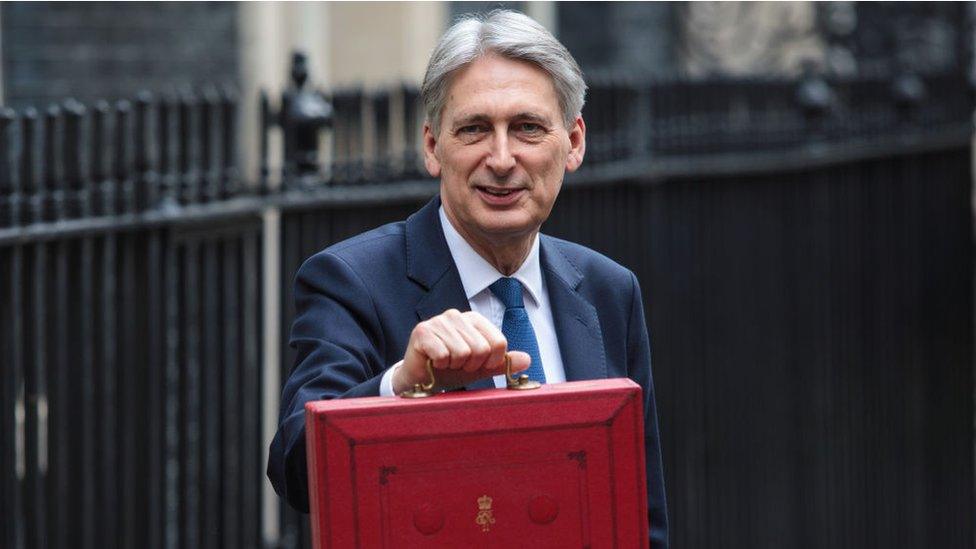Budget 2018: What we know already
- Published

The front cover may be striking, but few would find it a page-turner.
However, when it comes to our money, the Budget Red Book is probably the most significant publication of the year.
The 120 pages - even more if you count the supporting documents - outline the chancellor's plans for public and personal finances.
Yet the pages are far from fresh. Much of what is detailed in Philip Hammond's speech and in the book has already been announced. This may not be immediately clear, so here is some of what we already know.
Tax and your pay packet
A total of 31 million people pay income tax in the UK: 18 million men and 13 million women.
Some 25.6 million of these taxpayers pay income tax at the basic rate.
The amount earned a year before this basic rate of income tax is paid - called the personal allowance - stands at £11,850.
This is scheduled to rise in April and the Budget will show us by how much. The Conservative manifesto pledged that the first £12,500 of earnings would be free of income tax by 2020-21.

The higher rate of tax starts to be paid at £46,350. The government has already pledged to increase this to £50,000 by 2020-21.
The way income tax is levied is different in Scotland, owing to its devolved powers. The starter rate also begins when annual earnings reach £11,850, while the higher rate starts at £43,430.
Any changes will be announced in the Scottish Budget in December.


National insurance rates and any changes to capital gains tax will also be announced in the chancellor's Budget.
There has been some speculation that some self-employed people will no longer be free from some national insurance contributions.
The Treasury believes a third of people claiming self-employed status as a "personal service company" are actually full employees and should pay more tax.
Will there be a pay rise for public servants?
Public sector pay in England and Wales was frozen for two years in 2010, except for those earning less than £21,000 a year, and since 2013, rises have generally been capped at 1%.
However, with some fanfare, the government has said that the public sector pay cap has effectively been lifted.
There has been some flexibility with more significant pay rises for police, NHS workers and others.

However, these increases have needed to come from departmental budgets, so a squeeze on funding remains.
Any pay awards starting in April will be announced in the Budget.
The level of the National Minimum Wage and National Living Wage, currently £7.83 an hour, in April may also be part of the Budget declarations.
What about benefits?
This is going to be an area that is very closely watched, primarily as a result of Prime Minister Theresa May's speech at her party's recent conference.
In it, she said that austerity was over. Exactly how this is defined is open to debate.
Many working-age benefits will be three years through a four-year freeze by April. These include Jobseeker's Allowance, Employment and Support Allowance, some types of Housing Benefit, and Child Benefit.

Overall, out of £15bn of cuts to working age benefits announced since 2015 and scheduled to run until 2022-23, only £7bn have so far taken effect, according to the Institute for Fiscal Studies.
Some other benefits, including the state pension, maternity pay, and some disability allowances are likely to rise in line with inflation (2.4%) or, in the case of the state pension, in line with average wages (2.6%).
The chancellor is also under pressure from some of his own party's MPs to soften the impact of the gradual implementation of Universal Credit.
Employees who have been automatically enrolled into a pension will see the amount they need to contribute into their savings pot from their pay packet rise from 3% of their salary now to 5% in April. The contribution from their employer will go up from 2% to 3%.
Also in the pipeline
The gradual process allowing people to pass on property to their descendants free from some inheritance tax will enter its third year. It will reach its target by 2021.
Many buy-to-let landlords are seeing the amount of tax relief that they can claim on mortgage interest payments cut over the course of four years. The process began in April 2017. Eventually, they will only be able to claim at the lower rate of tax, not the higher.
There is the chance of private landlords receiving a tax break if they sell their property to a long-term tenant.

Also on the property front, April will see a change to the Rent a Room scheme - which allows people to earn up to £7,500 a year tax-free from letting out a spare room - will only be available to those living in the premises for some of the letting period.
Some changes to the way higher redundancy payments, company cars, and employee loans are taxed will also take effect in April.
Counting the pennies
One controversial, and somewhat hidden, proposal in the last Budget was the government paving the way for the end of 1p and 2p coins as it began a consultation on the future of cash.
A backlash followed and Downing Street had to make it clear that there was no plan for pennies to be dropped. At the end of that consultation, the Treasury confirmed that pennies would remain and there would be a new polymer £50 note. However, as the cost of living rises, and pennies hold less spending power, there is always a chance of the debate reigniting.
Will there be any giveaways?
The Prime Minister has already announced, again in her conference speech, that fuel duty will be frozen for the ninth year in a row.

The main rate of corporation tax is set to fall from the current level of 19% to 17% in April 2020, although there is speculation that this might be paused.
However, nobody is expecting any major giveaways as the chancellor has already been committed to giving the NHS an extra £20bn by 2023.
That money will have to be found from cuts or tax rises.
Where might that come from?
Some of the possibilities include cutting the tax relief available to higher earners putting their money into a pension; imposing VAT on private school fees; charging more tax from offshore gambling companies; and introducing a 3% stamp duty surcharge on overseas buyers who are not tax resident in the UK.
Overseas non-residential property owners already face a higher capital gains tax bill from April.
The chancellor might also increase Insurance Premium Tax (IPT), which stands at 12% and has been increased three times in recent years by government, from 6% in November 2015, but remains lower than the general VAT rate of 20%. Insurers say this has put up the cost of home and motor cover for millions of people.
However, with no Parliamentary majority the chancellor will be wary of introducing anything that will upset Tory voters and their MPs.
- Published29 October 2018

- Published26 September 2018

- Published11 October 2018